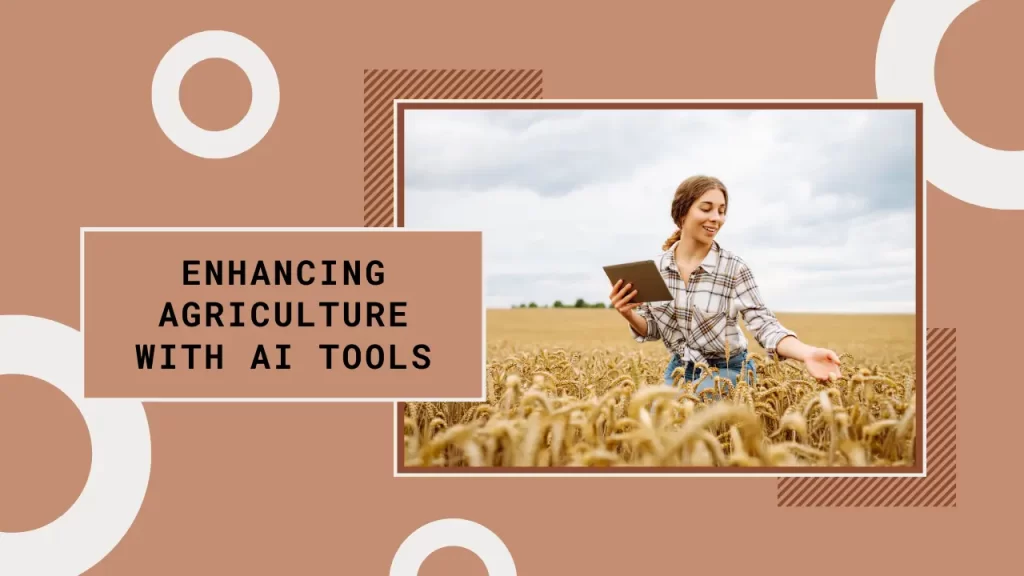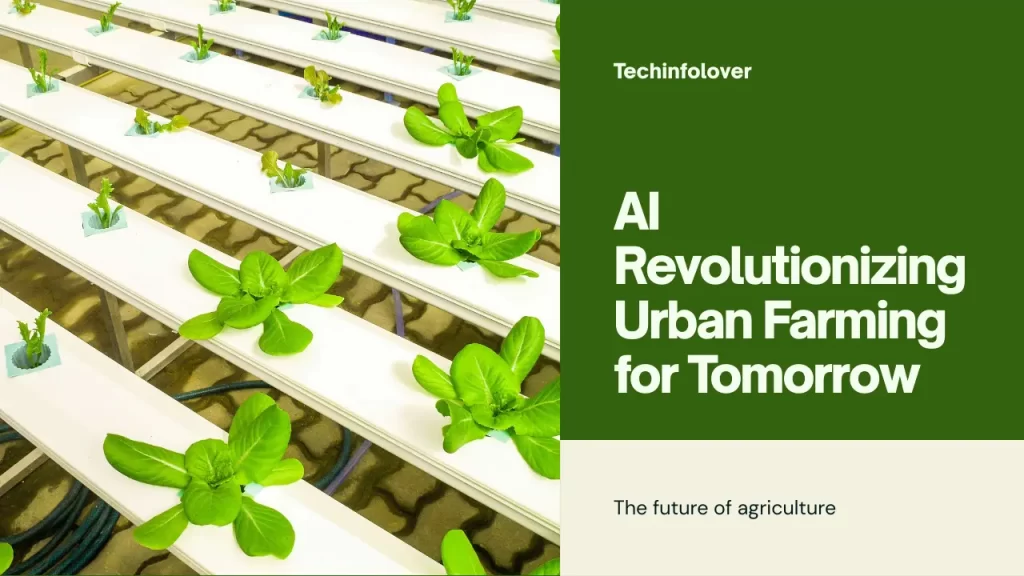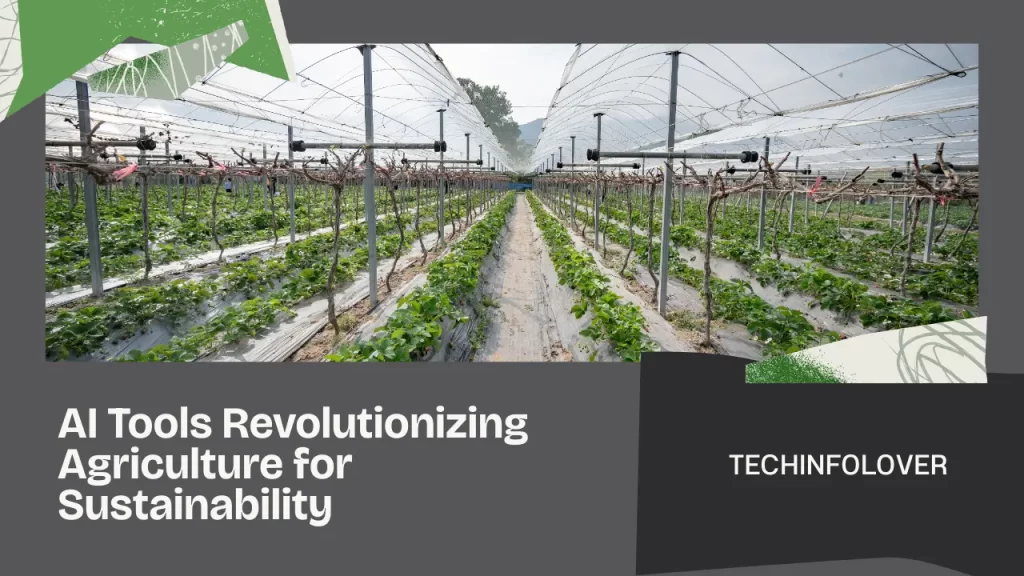The agriculture industry, a cornerstone of global economies, is undergoing a massive transformation. With the ever-growing demand for food and the challenges posed by climate change, farmers are turning to technology to help them increase efficiency, reduce waste, and improve crop yields. Among the most promising innovations in modern agriculture is Artificial Intelligence (AI). AI tools for agriculture are rapidly becoming indispensable for farmers, enabling them to make data-driven decisions, optimize their operations, and foster sustainable practices.
This article explores how AI tools for agriculture are revolutionizing the farming industry, the benefits they offer, and the various AI applications in agriculture that are helping farmers meet the demands of the future.
Introduction to AI in Agriculture
AI refers to the use of computer algorithms and machine learning models that enable machines to perform tasks typically requiring human intelligence, such as problem-solving, decision-making, and pattern recognition. In agriculture, AI tools are used to analyze vast amounts of data from various sources like satellites, sensors, and drones, providing actionable insights that can significantly improve farming practices.
The role of AI in agriculture is diverse, ranging from crop management to equipment automation. AI can help farmers optimize their resources, increase crop yields, reduce environmental impact, and address the growing challenges of a changing climate.

The Benefits of AI Tools for Agriculture
The integration of AI tools into agriculture offers a wide range of benefits that enhance the efficiency, productivity, and sustainability of farming operations:
- Improved Efficiency: AI-powered tools allow farmers to streamline their operations, automate routine tasks, and optimize resource use, reducing both labor costs and time spent on manual tasks.
- Increased Crop Yields: By analyzing data on soil conditions, weather patterns, and crop health, AI can predict optimal planting and harvesting times, resulting in better crop yields.
- Data-Driven Decision Making: AI tools provide farmers with real-time insights into their crops, weather conditions, and equipment status, enabling informed decisions that lead to improved profitability.
- Sustainability: AI promotes sustainable practices by helping farmers minimize the use of pesticides, fertilizers, and water while ensuring the health of the crops and soil.
- Risk Reduction: AI-powered predictive models can identify potential risks like pest outbreaks, weather anomalies, or disease threats, allowing farmers to take preventive measures and minimize losses.
AI Tools for Agriculture: Key Applications
AI tools for agriculture are transforming several aspects of farming operations. Below are some key applications where AI is making a significant impact.
Crop Monitoring and Disease Detection
AI-powered tools equipped with computer vision and machine learning models can monitor crops in real-time, detect diseases, and identify pests at an early stage. Drones and sensors can capture images of the fields, which are then processed using AI algorithms to identify potential issues. Early detection enables farmers to take corrective actions before problems spread, improving overall crop health and reducing the need for chemical treatments.
Examples:
- Plantix: This mobile app uses AI to diagnose plant diseases by analyzing pictures taken by farmers. It provides actionable advice for disease management and pest control.
- Taranis: Taranis uses high-resolution imagery captured by drones and AI algorithms to detect issues like pests, diseases, and nutrient deficiencies.
Precision Agriculture and Yield Prediction
AI tools allow farmers to optimize resource usage, including water, fertilizers, and pesticides, based on precise data gathered from sensors and satellite imagery. This method, known as precision agriculture, reduces waste and improves crop yield. AI models can analyze various factors such as soil health, weather conditions, and crop growth patterns to make accurate yield predictions, which help farmers plan better and allocate resources more effectively.
Examples:
- CropX: This soil sensor company provides farmers with real-time soil moisture data, enabling precise irrigation control to maximize water efficiency.
- IBM Watson Decision Platform for Agriculture: IBM’s AI platform integrates weather data, sensor information, and satellite imagery to offer insights into crop health, weather forecasts, and yield predictions.
Automated Irrigation Systems
AI-based automated irrigation systems use real-time data from weather forecasts, soil moisture levels, and crop needs to regulate irrigation schedules. These systems ensure that crops receive the right amount of water at the right time, reducing water waste and improving crop growth.
Examples:
- Rachio Smart Sprinkler: This system uses AI to adjust watering schedules based on weather conditions, soil moisture, and crop types, ensuring efficient water usage.
- Valmont: This company offers advanced irrigation systems that are powered by AI and can adjust water distribution according to real-time environmental conditions.
Autonomous Machinery and Drones
AI-powered autonomous machinery is revolutionizing the way farmers operate their equipment. Tractors, harvesters, and other machines can now operate autonomously, reducing the need for human labor and increasing operational efficiency. Drones, equipped with AI, can survey large fields, monitor crop health, and even apply fertilizers or pesticides with pinpoint accuracy.
Examples:
- John Deere Autonomous Tractors: These self-driving tractors use AI to navigate fields and carry out tasks like plowing, planting, and harvesting without human intervention.
- DJI Phantom 4 Multispectral Drone: This drone uses AI to collect high-resolution data on crop health, which is then analyzed to help farmers make informed decisions.
How AI Enhances Sustainability in Agriculture
AI tools are also playing a significant role in promoting sustainable agricultural practices. By optimizing the use of resources like water, pesticides, and fertilizers, AI reduces the environmental impact of farming. Moreover, AI-driven tools help farmers monitor soil health and biodiversity, ensuring that farming practices are sustainable in the long run.
For instance, AI can predict pest infestations or disease outbreaks with great accuracy, allowing farmers to take preventive measures that reduce the need for chemical interventions. Similarly, AI-powered precision farming techniques ensure that inputs such as water and fertilizer are used efficiently, reducing waste and minimizing environmental damage.
Challenges and Limitations of AI in Agriculture
While AI tools for agriculture offer many benefits, there are some challenges and limitations that need to be addressed:
- High Initial Investment: The cost of implementing AI tools can be prohibitive, especially for small-scale farmers. The upfront investment in sensors, drones, and AI software can be a barrier to adoption.
- Data Privacy Concerns: As AI tools rely on vast amounts of data, there are concerns about the privacy and security of the data collected from farms.
- Technological Barriers: Farmers in developing countries may lack the necessary infrastructure, such as reliable internet connections or access to modern technologies, to fully benefit from AI tools.
- Lack of Skilled Workforce: Implementing and maintaining AI tools requires specialized knowledge and skills. The shortage of skilled workers in rural areas can hinder the widespread adoption of AI in agriculture.
The Future of AI in Agriculture
The future of AI in agriculture looks promising, with the potential to drive significant advancements in farming practices. As AI technology continues to evolve, we can expect to see more advanced AI tools that can predict weather patterns with greater accuracy, improve crop disease detection, and enhance resource management. Additionally, with the integration of AI and IoT (Internet of Things), the agriculture industry will become more interconnected, enabling farmers to access real-time data and make faster, more informed decisions.
The rise of AI-powered robotics and automation will also reduce the reliance on manual labor and make farming more cost-effective and sustainable. As the technology becomes more affordable and accessible, its adoption is expected to increase, particularly among smallholder farmers in developing countries.
The Role of AI in Precision Livestock Farming
AI tools aren’t just transforming crop farming; they are also playing a vital role in livestock farming. Precision livestock farming uses AI technologies to monitor animal health, track behavior, and manage feeding systems. By integrating AI sensors and devices, farmers can optimize livestock management, improve animal welfare, and reduce the spread of diseases within herds.
Applications of AI in Livestock Farming:
- Health Monitoring: AI-powered wearable devices can track the vital signs and activity levels of livestock. If an animal shows signs of illness or distress, the system sends alerts to farmers, allowing for early intervention.
- Feed Optimization: AI systems can analyze data on animal health, behavior, and feed consumption to optimize feeding schedules and reduce feed waste.
- Behavioral Analysis: AI models analyze animal behavior, such as grazing patterns or sleep cycles, to detect potential health issues and improve productivity.

AI and the Future of Urban Farming
Urban farming is emerging as a solution to the challenges of feeding growing city populations. AI tools are helping urban farmers optimize space, increase yields, and improve sustainability in limited environments. From vertical farms to rooftop gardens, AI is enabling farmers to grow more food in urban settings.
Applications in Urban Farming:
- Vertical Farming: AI systems monitor and control environmental factors such as light, temperature, and humidity to create optimal growing conditions in vertical farming setups.
- Hydroponics and Aquaponics: AI tools help regulate water and nutrient levels in hydroponic and aquaponic systems, making urban farming more resource-efficient.
- Predictive Analytics: AI tools use weather forecasts, sensor data, and growth models to predict crop yields and optimize harvests in urban environments.
FAQs on AI Tools for Agriculture
Q1: How does AI improve crop yield prediction?
AI tools improve crop yield prediction by analyzing vast amounts of data such as weather patterns, soil health, and crop growth stages. Machine learning algorithms can forecast optimal planting and harvesting times, helping farmers manage resources more effectively and avoid crop losses due to timing issues.
Q2: Are AI tools in agriculture affordable for small-scale farmers?
While the initial cost of AI tools can be high, especially for small-scale farmers, the benefits they bring in terms of increased productivity and resource optimization can lead to long-term cost savings. Additionally, as technology advances, the cost of AI tools is expected to decrease, making them more accessible to smallholder farmers.
Q3: What role do drones play in AI-powered agriculture?
Drones equipped with AI technology play a crucial role in crop monitoring, field mapping, and data collection. They capture high-resolution images of crops, which AI tools analyze to detect pests, diseases, and nutrient deficiencies. Drones can also be used for precision spraying of fertilizers and pesticides, reducing the use of chemicals.
Q4: How can AI help in sustainable farming practices?
AI can help farmers practice sustainability by optimizing resource usage such as water, fertilizers, and pesticides. AI-powered systems provide precise recommendations based on real-time data, reducing waste and minimizing the environmental impact of farming. Additionally, AI can predict weather patterns, allowing farmers to adapt to changing conditions and prevent resource wastage.
Q5: What are some examples of AI tools used for livestock farming?
AI tools used for livestock farming include health monitoring systems like wearable devices that track animal activity and vital signs, AI-driven feeding systems that optimize feed consumption, and behavioral analysis tools that detect signs of illness or stress in animals. These technologies help improve animal welfare and optimize herd management practices.
Q6: How is AI used in urban farming?
AI is used in urban farming to monitor and control environmental conditions in spaces like vertical farms and rooftop gardens. AI tools optimize factors such as light, temperature, and humidity, ensuring optimal growth conditions for crops. Additionally, AI assists in managing hydroponic systems, predicting yields, and maximizing the use of limited urban space.
Conclusion
AI tools for agriculture are transforming the way we approach farming, offering innovative solutions to increase productivity, reduce environmental impact, and improve sustainability. By integrating AI into their operations, farmers can enhance their decision-making, optimize resources, and achieve better yields. As the agriculture industry faces new challenges brought on by climate change and a growing global population, AI provides a promising path forward to ensure food security and a sustainable future.
The widespread adoption of AI in agriculture is still in its early stages, but with continued advancements in technology, it holds the potential to revolutionize farming for generations to come.

